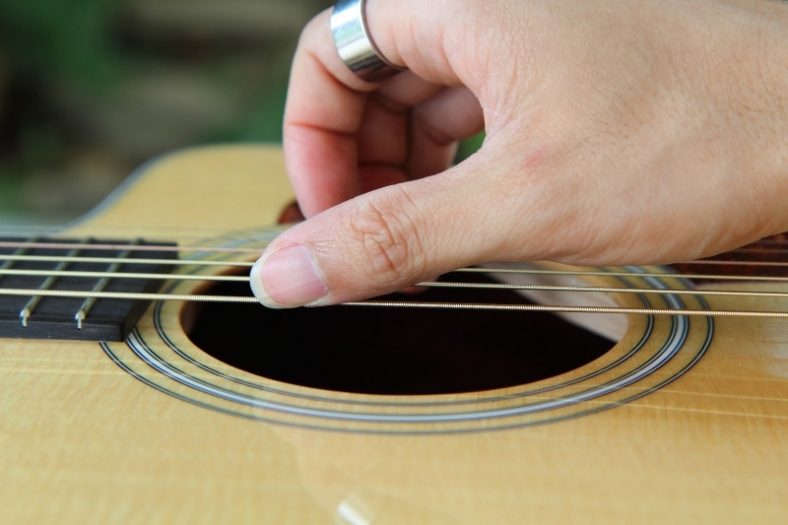Why Do Some Guitarists Have Long Nails?

Although long nails may can be a hindrance for many guitar styles, they can greatly enhance tone and volume in fingerstyle techniques.
Having long nails on the picking hand is like having an additional pick on each finger. Using both the actual finger and nail to pluck a string gives smooth, clear, and loud sounds that cannot be achieved with just the flesh.
Contents
Benefits of long nails for guitar players
Compared to even other acoustic instruments, the acoustic guitar is a relatively quiet instrument. Picking a string with your finger gives a warm tone, but it is difficult to project the sound across large halls or venues.
Using the fingernail along with the flesh increases the attack and volume of the note, while also adding brightness to the tone.
Long nails are especially suited to guitar styles that involve mostly fingerpicking, as opposed to strumming, tapping, or slapping. Fingerstyle techniques are naturally much easier and smoother to play with three or four fingers, as opposed to with a flat pick or plectrum.
Guitarists who do not use flat picks usually prefer nylon strings, as they are easier on bare fingers. However, even with steel strings, guitarists usually prefer the sound of plucking strings first by the flesh on the ends of fingers, then lightly brushing the nail as the finger moves upward.
Downsides of long nails for guitar players
Long nails are more difficult to maintain and can get damaged easily in day-to-day activities. Longer nails can also snag or catch on the strings while playing, thus risking both nail damage, as well as undesirable sounds during the performance.
Long nails on the fretting hand make playing impossible, unless you want to play only a few major barre chords on open tunings, and thereby avoid fretting notes altogether. The nail will obstruct the finger from completely pressing down on the string. Also, nails themselves cannot be used to fret notes because they do not have enough surface area or strength.
Tapping techniques – where frets are pressed with both hands, thus become difficult to achieve even if only the picking hand (or right hand, if you are right-handed) has long nails.
Also, slapping the strings with long nails on that hand increases the possibility of them catching or snagging on the strings.
This is why even guitarists who primarily play fingerstyle tend to avoid long nails because they interfere with slapping and tapping techniques.
Not to mention that trying to hold a pick close to the strings is next to impossible if you have longer nails. The closer you hold the pick, the more you risk brushing nails and creating unwanted sounds. So for hybrid picking, for instance, you will have to keep the nails on your thumb and index finger short.
How to maintain them?
You can choose your nail length and shape depending on your playing style, experience level, and personal preferences.
Some nail shapes like the up-ramp offer much less resistance and require less energy to move fingers through the strings. Additionally, more distance between the contact and release point implies that the sound will be bigger and brighter.
On the downside, even small adjustments in nail length lead to very noticeable changes in tone. Plus, for beginners who may not be sure of where to make contact with the string, there is a higher possibility of snagging or catching.
On the other hand, the rounded or half-moon shape is the most common, easiest to play with, and gives a reasonable, balanced tone. It is a good option for beginners since the contact point doesn’t matter and the rounded shape is also easier to maintain.
Avoid nail clippers to shape and maintain your nails. Instead, use a metal file to roughly shape the nail. Then, use a buffer for a more refined finish. Lastly, rub a bit of sandpaper against the nail to make sure that it is completely smooth, and has no bumps or irregularities at all.
A smooth, refined finish is essential to achieve the best tone.
Your diet also affects the strength of your nails. Inadequate nutrients and an unhealthy lifestyle can make your nails dry and brittle, and thus more prone to breaking or chipping. Load up on proteins and vegetables for healthy, strong nails.
If your nail cracks or starts to split, you can repair your nail by using super glue. Take a look at what’s broken and glue it up. Use some acrylic powder with the glue to reinforce the patch. Repairing damaged nails will save you from losing 1-2 weeks of playing time as you wait for the nail to regrow.
What styles are better suited for longer nails?
Guitar styles that involve fingerpicking or fingerstyle are best suited for long nails. These include classical guitar, flamenco, country music, and even jazz. Again, long nails are useful only on the picking hand, and not the fretting hand.
Almost every serious classical guitarist uses fingernails on the picking hand. They give a loud, clear, and brilliant sound, and slight changes in the nail can have drastic effects on tone quality and volume. Different nail lengths and shapes are better suited for different techniques of the classical guitar – such as rest stroke or free stroke.
A lot of techniques in flamenco, such as Rasgueado or Golpe rely even more heavily on the nails. Rasgueado involves strumming the strings with the back of the nails. On the other hand, Golpe involves hitting the body of the guitar with the tip of either the ring or middle finger along with a little bit of the nail.
Country music often involves a lot of hybrid picking. Hybrid picking is when the guitarist plays with the pick along with the ring and middle fingers. It allows fingerstyle-like passages to be freely interspersed with flat-picked passages. Country musicians may find it beneficial to keep long nails on their middle and ring fingers.
Some alternatives to growing your nails
If you are put off by the idea of constantly maintaining and shaping your nails, or feel that long nails will interfere in your daily life, there are multiple alternatives.
You can always use acrylic nails made for guitar players. Good quality acrylic nails are durable even for steel strings and flamenco players and offer a lot of flexibility in the sound and tone. Putting them on and taking them off is a relatively easy DIY process, but if needed you can always hop over to the nail salon to get it done.
Finger picks are another option. You can slide them over your finger like a ring, and use them like you would use your nails. However, these are more likely to fall off, and some guitarists say that they feel unnatural.
If none of these alternatives suit you, you can always avoid nails altogether, and stick to using the flesh on the end of your fingers.
How long are long nails?
When it comes to guitar playing, if the fingernail extends beyond the flesh of your finger, that is a long nail.
However, a nail length of 1 – 3 mm above the flesh is useful for fingerstyle. Classical guitarists often maintain a nail length of 2-3 mm on their index, ring, and middle fingers, while a nail length of around 5 mm on their thumb.
When filing your nails, make sure your nail isn’t too long. If the nail extends beyond a certain length, it is likely that only the nail, and none of the flesh, will hit the string. This will give an unwanted clicking sound, and also risk chipping or damage to the nail.
Summary
Nails are an essential part of guitar playing but are not for everybody. However, if you do decide to grow your nails out, it is important that you take care of them. Long nails give a distinct advantage in terms of tone quality, volume, and technique.
However, some guitarists prefer to use alternative means of playing instead of growing their nails out. And if you are determined to keep your fingernails short, there are always alternatives such as fingerpicks or acrylic fingernails.





